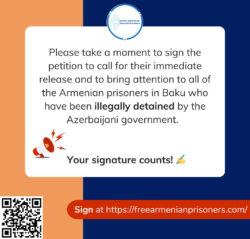HISTORICAL BACKGROUND:
Historically Armenian, Artsakh was connected to Armenia in ancient times, a connection that was lost after the division of the Armenian Kingdom in 387 AD. With the rise of Islam in the seventh century, Artsakh fell under Arab rule, where it stayed for 300 years.
In the eleventh century, Artsakh came under the rule of the Bagratid Kings of Georgia, relatives of the Armenian Bagratids, who held it until the Mongol invasion. After 100 years of Mongol rule, Artsakh fell into Turkish hands, where it stayed until the Persians took power in the early 1600s.
In 1603, Shah Abbas the Great of Persia allowed local Armenian rule in Artsakh under five meliks (kings). These five kinglets, later joined—but not supplanted—by a Muslim khanate, survived until the Russian conquest of Artsakh in 1828.
Under Russian rule, a deliberate effort was made to link Artsakh economically with the “Baku Province,” later to be named Azerbaijan. With the withdrawal of Russian power following the Russian democratic revolution in February/March of 1917, Artsakh reemerged as a state, governed by the Assembly of Artsakh Armenians.
The Azerbaijanis, who were trying to organize their own state, contested the Armenians’ right to rule Artsakh, even though it was overwhelmingly Armenian. The Azeris first turned for help to the British occupation force led by General Dunsterville, then to the Ottoman army under Nuri Pasha, and finally to the Russian Bolsheviks. With foreign aid, they won out.
SOVIET PERIOD:
At first the Soviets returned Artsakh to Armenia; but after a brief period, Joseph Stalin gave it to Azerbaijan as an “autonomous region,” and altered the boundaries so that Artsakh was cut off from Armenia and was smaller in size.
The next 70-plus years witnessed Azeri persecution of Armenians in an attempt to drive them out and replace them with Azeris, as was done in the Armenian territory of Nakhichevan.
In the Gorbachev era of glasnost, the Armenians brought the persecution of their brethren to the world’s attention through massive peaceful demonstrations in Yerevan, the capital city of Armenia, in February 1988.
By openly and bravely protesting Soviet ethnic injustice for the first time, the reform movement in Artsakh ignited the independence movements in the Soviet Bloc of Eastern Europe. The “Karabagh Movement” or “Artsakh Movement” is thus the grandfather of freedom not only in Eastern Europe but in the former USSR itself.
At that time the Armenians wanted to attach Artsakh to Armenia, to ensure its survival, but now they respect the wishes of the Artsakh Armenians to be independent. The independence movement has been met with appalling violence from the Azeris:
- In February 1988 there was a pogrom (massacre) against Armenians in Sumgait, a suburb of Baku, the capital of Azerbaijan.
- In November of 1988, there was a pogrom against Armenians in Kirovabad (now Ganja), in the interior of Azerbaijan.
- In 1989-90, there were joint Soviet-Azerbaijani forced deportations of Armenians living in towns and villages of Azerbaijan bordering Artsakh.
- In January of 1990, there was pogrom against Armenians in Baku itself.
When the Azeris began an outright military assault on the Armenians of Artsakh itself, the Armenians took up arms to defend their homes, their land, and their ancient culture. The Armenians are fighting for self-preservation and for the right of self-determination, while the Azeris are fighting to expel an ancient people from their historic homeland and to preserve power over a foreign province.
Today, a tenuous cease-fire is in place. However, the Azeris number eight million and have a wealth of oil resources to draw upon, and the Armenians of Artsakh only 160,000 and scant resources. Very little would prevent the Azeris from reopening hostilities and starting a full-scale war with oil money in its coffers. A genocide similar to that of 1915 is threatened unless the world takes an interest in and protects the lives of the embattled Armenian minority.




